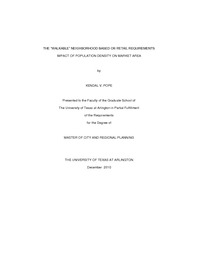
ATTENTION: The works hosted here are being migrated to a new repository that will consolidate resources, improve discoverability, and better show UTA's research impact on the global community. We will update authors as the migration progresses. Please see MavMatrix for more information.
Show simple item record
| dc.contributor.author | Pope, Kendal V. | en_US |
| dc.date.accessioned | 2011-03-03T21:52:00Z | |
| dc.date.available | 2011-03-03T21:52:00Z | |
| dc.date.issued | 2011-03-03 | |
| dc.date.submitted | January 2010 | en_US |
| dc.identifier.other | DISS-10866 | en_US |
| dc.identifier.uri | http://hdl.handle.net/10106/5460 | |
| dc.description.abstract | Recent planning thought has focused on how to configure the city to reduce dependence on private automobiles. One important strain of this thinking is how to promote a city where daily needs can be satisfied on foot. Using the tools of Central Place Theory and Demand Threshold analysis, this work studies the required population density to bring grocery shopping within pedestrian range of the population. The analysis is based on the grocery market in Dallas County, Texas. As long as economies of scale and consumer price sensitivity continue to operate as they have, the alternatives will remain much higher density or only partial access. The suggested policy implication is that neighborhood design issues should be decoupled from economic land-use arguments for the purposes of discussion by policy makers. | en_US |
| dc.description.sponsorship | Anjomani, Ardeshir | en_US |
| dc.language.iso | en | en_US |
| dc.publisher | Urban & Public Affairs | en_US |
| dc.title | The Walkable Neighborhood Based On Retail Requirements: Impact Of Population Density On Market Area | en_US |
| dc.type | M.C.R.P. | en_US |
| dc.contributor.committeeChair | Anjomani, Ardeshir | en_US |
| dc.degree.department | Urban & Public Affairs | en_US |
| dc.degree.discipline | Urban & Public Affairs | en_US |
| dc.degree.grantor | University of Texas at Arlington | en_US |
| dc.degree.level | masters | en_US |
| dc.degree.name | M.C.R.P. | en_US |
Files in this item
- Name:
- Pope_uta_2502M_10866.pdf
- Size:
- 1.593Mb
- Format:
- PDF
This item appears in the following Collection(s)
Show simple item record


